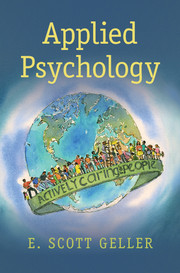Book contents
- Frontmatter
- Dedication
- Contents
- Foreword
- Preface: The Actively Caring for People (AC4P) Movement
- About the Authors
- Acknowledgments
- INTRODUCTION TO PART I EVIDENCE-BASED PRINCIPLES OF AC4P
- INTRODUCTION TO PART II APPLICATIONS OF AC4P PRINCIPLES
- 9 Actively Caring for Occupational Safety
- 10 Cultivating an AC4P Culture in Organizations
- 11 Actively Caring for Traffic Safety
- 12 Actively Caring to Prevent Alcohol Abuse
- 13 Actively Caring for Obesity
- 14 Actively Caring for Patient-Centered Healthcare
- 15 Actively Caring for Our Children
- 16 Actively Caring for Preschoolers
- 17 Actively Caring Coaching for Young Athletes
- 18 Actively Caring for Higher Education
- 19 Actively Caring for Mother Earth
- 20 The AC4P Power of Pets
- Epilogue: Where Do We Go from Here?
- Subject and Name Index
- References
18 - Actively Caring for Higher Education
from INTRODUCTION TO PART II - APPLICATIONS OF AC4P PRINCIPLES
Published online by Cambridge University Press: 05 March 2016
- Frontmatter
- Dedication
- Contents
- Foreword
- Preface: The Actively Caring for People (AC4P) Movement
- About the Authors
- Acknowledgments
- INTRODUCTION TO PART I EVIDENCE-BASED PRINCIPLES OF AC4P
- INTRODUCTION TO PART II APPLICATIONS OF AC4P PRINCIPLES
- 9 Actively Caring for Occupational Safety
- 10 Cultivating an AC4P Culture in Organizations
- 11 Actively Caring for Traffic Safety
- 12 Actively Caring to Prevent Alcohol Abuse
- 13 Actively Caring for Obesity
- 14 Actively Caring for Patient-Centered Healthcare
- 15 Actively Caring for Our Children
- 16 Actively Caring for Preschoolers
- 17 Actively Caring Coaching for Young Athletes
- 18 Actively Caring for Higher Education
- 19 Actively Caring for Mother Earth
- 20 The AC4P Power of Pets
- Epilogue: Where Do We Go from Here?
- Subject and Name Index
- References
Summary
I never teach my pupils, I only attempt to provide the conditions in which they can learn.
– Albert EinsteinAction needs to be taken to improve education in the United States. The United States ranked seventeenth among thirty-four Organizations for Economic Co-operation and Development (OECD) countries in the 2012 results of the Programme for International Student Assessment (PISA). The PISA is a standardized test of math, science, and reading comprehension skills, and is administered to more than five hundred thousand 15-year-olds internationally. At the forefront are students from China, Singapore, Korea, Japan, and Liechtenstein with mean PISA scores of 613, 573, 554, 536, and 535, respectively. With a mean score of 481, U.S. students scored significantly lower than the international average of 494, trailing Spain, the Russian Federation, and the Slovak Republic.
According to the OECD, the assessment gauges knowledge and skills of students, which helps policymakers target and set reasonable goals in their education systems. The disconcerting PISA score of U.S. 15-year-olds raises several questions: What underlying factors contribute to relatively poor academic performance in the United States? What can be done to improve academic performance? Is it too late?
We do not believe it's too late; but a solution requires a greater understanding of the activators and consequences that affect academic-related behavior.
In Declining by Degrees, Hersh and Merrow provide insight into possible reasons our American education system is failing. These include (a) the belief that college does nothing more than prepare students for a job; (b) the inability of educators to effectively communicate information to students; (c) the disconnection between supply and demand for available courses; (d) an emphasis on teaching to assessment exams; and (e) insufficient preparation for college, among other factors.
Despite these barriers, we believe principles of applied behavioral science (ABS) can provide guidance for students, parents, educators, and the community as a whole toward a brighter future for education in the United States and beyond.
A MODEL FOR IMPROVING THE COLLEGE EXPERIENCE
The activator-behavior-consequence (ABC) model of ABS has a long and rich history of improving students’ classroom performance. Instructors and researchers have demonstrated methods to improve class attendance and punctuality, ways to improve course structure so students can allocate more time for studying, and approaches to enhancing students’ ability to take notes during class lectures.
- Type
- Chapter
- Information
- Applied PsychologyActively Caring for People, pp. 563 - 593Publisher: Cambridge University PressPrint publication year: 2016
References
- 1
- Cited by



